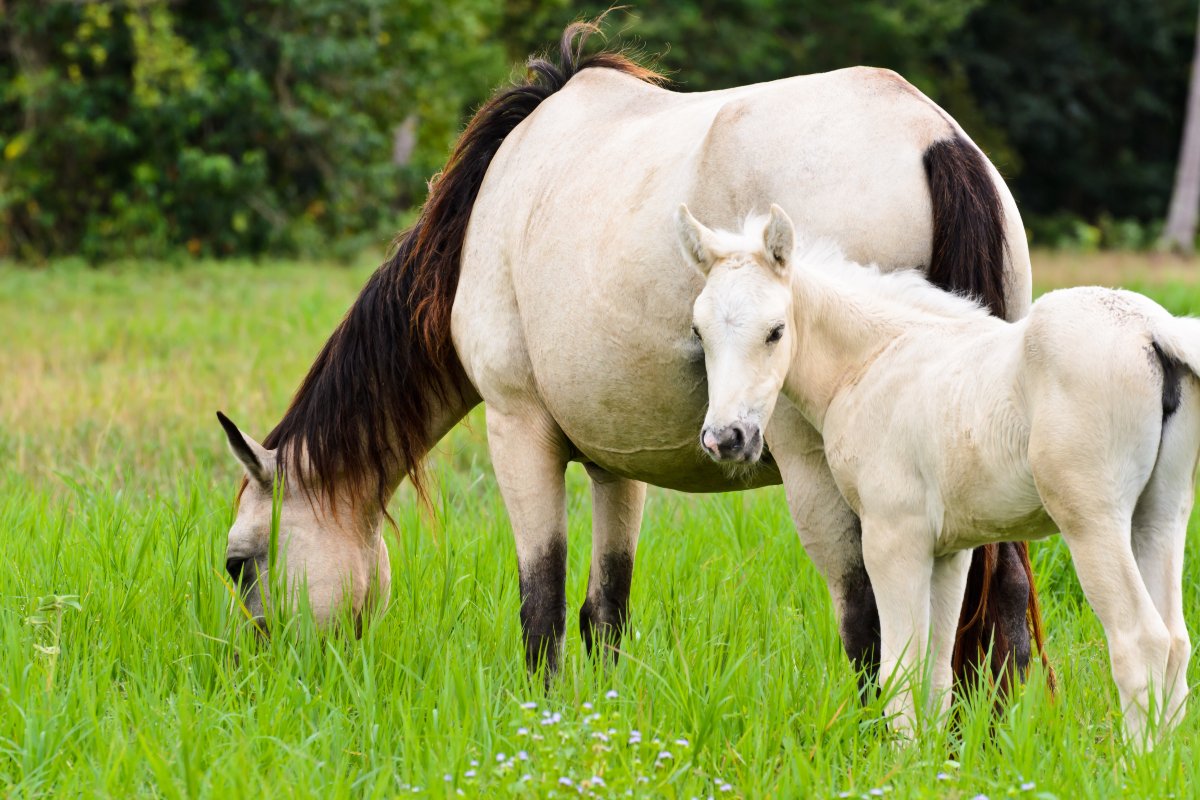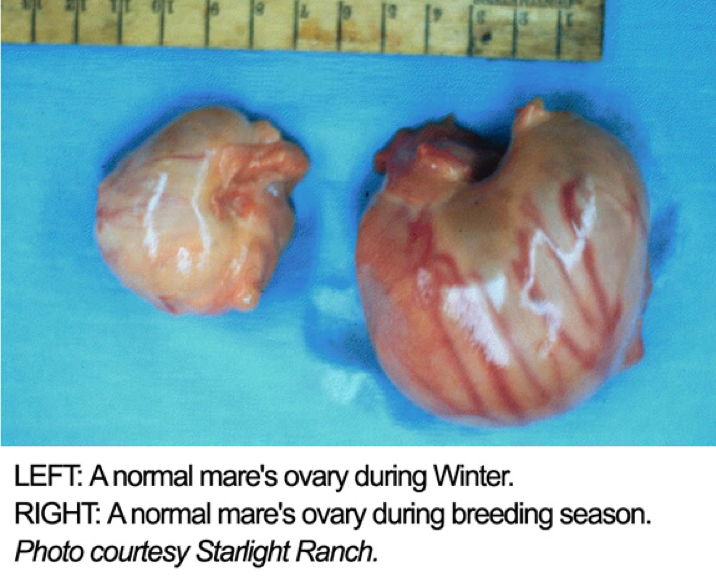How Long Do Horses Ovulate?

Mares cycle when days are long and there is abundant daylight during most of the day, meaning that under normal circumstances, they cycle in the Spring, Summer and Fall. Mares do not cycle in Winter when daylight is short; this is known as anestrus. During anestrus, the uterus is flaccid, and the ovaries are inactive with no significant follicles or corpora lutea. The cervix may be closed but not firm and tight, or it may be thin, short, and dilated.1
As the length of daylight increases with the onset of Spring, the ovaries become active once again. Their cycle resumes, and the ovaries begin to produce follicles, but ovulation does not occur immediately. "Mares have three or four prolonged intervals of estrus (periods of sexual receptivity to the stallion) during the vernal transition, but ovulation does not occur. The end of vernal transition is marked by a surge of luteinizing hormone and subsequent ovulation. After this ovulation, the first 21-day interovulatory period of that breeding season occurs and a regular estrous cycle is established."1
| Reproductive Life of the Mare | |
| Sexual maturity | Approx 18 months |
| Estrous cycle | 22 days |
| Estrus (fertile) length | 6 to 8 days |
| Diestrus (not fertile) length | 14 to 16 days |
| Gestation period | 340 days |
| Postpartum heat | 7 days after parturition |
Mares have two follicular waves each cycle. Although the mare continues to ovulate regularly every 21 days throughout the breeding season, the length of estrus varies, ranging from two to eight days, and the length of diestrus varies accordingly to maintain a 21-day interval.1 Early in the breeding season, estrus tends to be longer, whereas around the summer solstice the mare may be sexually receptive for only two to three days.

Predicting Ovulation in the Mare
"In horses, a breeding is only as effective as your ability to predict a mare’s impending ovulation."2 That said, there are a plethora of factors that impact the mare's cycle, when she will ovulate, and the approximate lengths of time before, during and after ovulation.
Other than the mare's general health and diet, these factors include:
- Reproductive history - Many broodmares ovulate a follicle of similar diameter (important because follicle size indicates impending ovulation) each cycle. For these predictable mares, veterinarians can often use data from previous cycles to estimate ovulation.
- Follicle growth pattern - The mare’s dominant follicle typically increases in diameter by 2.7-3 mm a day during estrus. This growth ultimately peaks and holds steady for about a day or two prior to ovulation and might even decrease by 2-3 mm within the 12 hours before ovulation.
- Follicle diameter - Veterinarians can predict the diameter a preovulatory follicle is going to reach based on the mare's size and breed. The smaller the breed, for instance, the smaller the follicle.
- Follicle shape - Developing follicles are spherical during most of estrus and most lose their shape around 12-24 hours prior to ovulation.
- Follicle wall changes - A follicle’s wall thickness increases as the interval to ovulation decreases. Other changes also occur as ovulation nears, such as rents or tears in the wall, which occur about 77% of the time. During ovulation itself, the wall collapses.
- Follicle tone - Early in the growth phase, follicles feel firm on manual palpation. In the 12-24 hours before ovulation, they often become noticeably softer.
- Uterine edema - Fluid swelling within the uterine lining develops with the presence of estrogen and the absence of progesterone and peaks about two days prior to ovulation. Ovulation occurs as this edema declines or disappears.
- Cervical relaxation - Also in response to increased estrogen levels and an absence of progesterone, the mare’s cervix relaxes, as detectable via rectal palpation or vaginal exam.
- Ovarian pain - Some mares experience pain associated with follicle development and, more commonly, exhibit discomfort when the veterinarian palpates the site of a fresh ovulation.
- Number of days in estrus - The average equine estrous cycle is 20.6 days, and the average duration of estrus is 5.7 days. 46%, 32%, and 12% of mares ovulate within 24, 48, or 72 hours, respectively, prior to the end of estrus, while 10% of mares were out of estrus before ovulation occurred.2
Finally, if the mare has been given prostaglandins or other agents to induce ovulation, schedules must be adjusted accordingly, since this will bring on earlier ovulation.
Equine Breeding Products
You can find equine breeding products in our online store. Login to your account to view prices and purchase or create an account. Please note you must have a valid veterinarian license to create an account. If you do not, please forward our information to your veterinarian.
1Sertich,
P., DVM. Reproductive Cycle in Horses,
Merck Veterinary Manual, 2019.
2Beckstett, A. 13 Ways to
Predict Ovulation in Mares. The Horse, AAEP Convention 2014.
About NexGen Pharmaceuticals
NexGen Pharmaceuticals is an industry-leading veterinary compounding pharmacy, offering sterile and non-sterile compounding services nationwide. Unlike other veterinary compounding pharmacies, NexGen focuses on drugs that are difficult to find or are no longer available due to manufacturer discontinuance or have yet to be offered commercially for veterinary applications, but which still serve a critical need for our customers. We also specialize in wildlife pharmaceuticals, including sedatives and their antagonists, offering many unique options to serve a wide array of zoo animal and wildlife immobilization and anesthesia requirements.
Our pharmacists are also encouraged to develop strong working relationships with our veterinarians in order to better care for veterinary patients. Such relationships foster an ever-increasing knowledge base upon which pharmacists and veterinarians can draw, making both significantly more effective in their professional roles.
Disclaimer
The information contained in this blog post is general in nature and is intended for use as an informational aid. It does not cover all possible uses, actions, precautions, side effects, or interactions of the medications shown, nor is the information intended as medical advice or diagnosis for individual health problems or for making an evaluation as to the risks and benefits of using a particular medication. You should consult your veterinarian about diagnosis and treatment of any health problems. Information and statements have not been evaluated by the Food and Drug Administration ("FDA"), nor has the FDA approved the medications to diagnose, cure or prevent disease. Medications compounded by NexGen Pharmaceuticals are prepared at the direction of a veterinarian. NexGen Pharmaceuticals compounded veterinary preparations are not intended for use in food and food-producing animals.
NexGen Pharmaceuticals, LLC does not recommend, endorse or make any representation about the efficacy, appropriateness or suitability of any specific dosing, products, procedures, treatments, services, opinions, veterinary care providers or other information that may be contained in this blog post. NEXGEN PHARMACEUTICALS, LLC IS NOT RESPONSIBLE NOR LIABLE FOR ANY ADVICE, COURSE OF TREATMENT, DIAGNOSIS OR ANY OTHER INFORMATION, SERVICES OR PRODUCTS THAT YOU OBTAIN THROUGH THIS BLOG POST.



